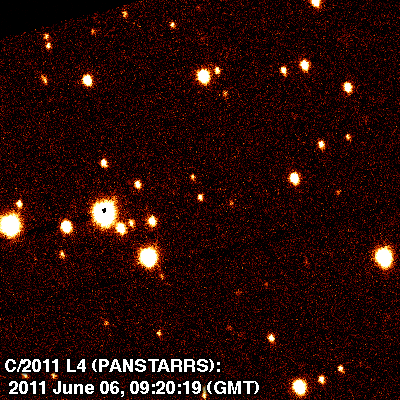Coming soon to a sky near you – comet C/2011 L4 (PANSTARRS)
June 16th, 2011 by richardwainscoatThe Pan-STARRS 1 telescope has discovered a new comet that is expected to be visible to the naked eye in early 2013. The comet is now about 1.2 billion km from the sun, beyond the orbit of Jupiter. It is currently about magnitude 18.5 making it 100,000 times too faint to be seen with the naked eye meaning it can only be observed with a telescope and a sensitive electronic detector. The predicted geometry of the comet’s approach to the sun is not ideal – it will pass behind the sun, on the opposite side of the sun to Earth. This will make viewing the comet difficult. The comet has a highly inclined orbit, and will approach the Earth and Sun from the south, then move into the northern sky after perihelion (its closest approach to the Sun). In March 2013, the comet is expected to be visible low in the western sky after sunset, but the bright twilight sky may make it difficult to view. The comet is predicted to reach approximately magnitude 1 near perihelion meaning it will be of the same brightness as some of the brighter stars in the sky. However its close proximity to the Sun will make viewing difficult.

Comet C/2011 L4 moving across the sky. Credit PS1SC/Henry Hsieh
Pan-STARRS 1 is a 1.8-meter-diameter telescope equipped with the largest digital camera in the world (1.4 billion pixels). Each image is almost 3 gigabytes in size, and the camera takes an image approximately every 45 seconds. Each night, the telescope images more than 1,000 square degrees of the night sky (an area 5,000 times the size of the full moon). The comet was found while searching the sky for potentially hazardous asteroids—ones that may someday hit Earth. Software engineer Larry Denneau, with help from astronomers Robert Jedicke, Mikael Granvik, Tommy Grav and Richard Wainscoat designed software that searches each image taken by the Pan-STARRS 1 telescope for moving objects. Denneau, and UH astronomers Henry Hsieh and Jan Kleyna also wrote other software that searches the moving objects for comets’ tell-tale fuzzy appearance. The comet was identified by this automated software.
The comet is named C/2011 L4 (PANSTARRS). Comets are usually named after their discoverers, but in this case, because a large team, including observers, computer scientists, and astronomers, was involved, the comet is named after the telescope. This is the second comet discovered by Pan-STARRS 1. The first comet, P/2010 T2 (PANSTARRS) is a Jupiter Family Comet that will never become bright enough to see without the aid of a telescope.
C/2011 L4 (PANSTARRS) was found on the night of June 5-6, and we confirmed it the following night using the Canada-France-Hawaii Telescope on Mauna Kea. We have just found precovery images from the night of May 20-21, and using positional measurements from those images, calculate that the comet will reach perihelion around March 10, 2013, with a perihelion distance of 0.30 AU, or about 45 million km or 30% of the distance from the Earth to the Sun, and inside the orbit of the planet Mercury. The comet’s orbit may be parabolic meaning this may be the first time it has come close to the Sun, and it may never return. This is because we estimate that it has an eccentricity (a measure of how non-circular the orbit is) close to 1. It will not be known for several months whether the orbit is elliptical (with eccentricity less than 1), which would mean that it is a returning comet. Over the next few months, we will continue to study the comet, and this will allow better predictions of how bright it will eventually get. Predicting the brightness of comets is notoriously difficult, with numerous past comets failing to reach their expected brightness. The difficulty in making brightness predictions lies in the fact that for new comets, astronomers do not know in advance how much ice they contain. Because sublimation of ice (conversion from solid to gas) is the source of cometary activity and a major contributor to a comet’s overall eventual brightness, this means that more accurate brightness predictions will not be possible until the comet becomes more active as it approaches the sun, and astronomers get a better idea of how icy it is.
C/2011 L4 (PANSTARRS) most likely originated in the Oort cloud, a cloud of comet-like objects located in the distant outer solar system. It was probably gravitationally disturbed by a distant passing star, sending it on a long journey toward the sun. Comets like C/2011 L4 (PANSTARRS) offer astronomers a rare opportunity to look at pristine material left over from the early formation of the solar system.










